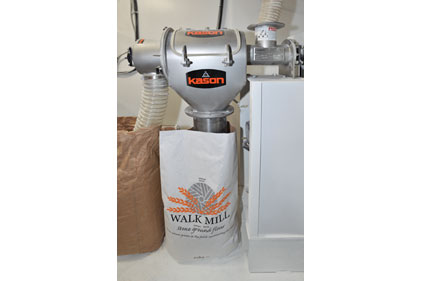Dry Processing
Keep the mill wheels grinding
A new flour mill uses traditional milling techniques with a state-of-the-art screener.


|
| The Centri-Sifter centrifugal screener separates the flour from the rest of the ground material. The separated flour in 55-lb. (25kg) sacks is ready for shipping. Source: Kason. |
Rebuilt as a replica of a 13th century mill, Walk Mill is a modern flour mill that uses water power to grind wheat with stone grinding wheels coupled with electrical augers and a modern centrifugal screener. Located near Chester, England, the mill serves two markets: upscale hotels and restaurants that make their own bread and the retail market.
Started up in 2008, the mill uses a steel waterwheel fed by a stream diverted from the nearby river. The last mill on the site ceased production in 1915, and only the footprint of the building was left, according to Ben Jones, a partner in the family-owned business, who is in charge of mill operations. “We dug the foundations to find the footprint of the building, and we also had a lot of photographs of the old mill. From the footprint and pictures we were able to construct a building that is exactly like the old mill on the outside.”
Walk Mill uses two burr stones made of hard, dense French granite. The stones are positioned horizontally, one above the other. The lower stone (called a bedder) is fixed while the upper runner stone rotates. Wheat, conveyed from a hopper on the first floor, falls into a hole in the center of the upper stone and gradually moves to the periphery of the stones via shallow grooves in the stones. The gap is adjusted to produce white or whole meal flour, the latter being more coarse as it contains bran.
Both the stone rotation and feed rate from the hopper are governed and synchronized by a shaft that is geared to the waterwheel. “It’s self regulating,” says Jones. “If the water flow increases, the feeding and milling operations increase at the same rate.” Jones says a shaft rotation of 40rpm yields the best-quality flour. The relatively slow, gentle process avoids overheating of the flour and preserves all the good parts of the grain: protein, oils, vitamins, sugars, starches and bran.
As the flour leaves the millstones, it is swept by a blade attached to the upper stone and falls into a 28-lb. transit hopper. An auger transfers the product to a spout that feeds a Kason Corp. Centri-Sifter that separates the flour from the rest of the material. The model GOB-SS machine has a sifting area of 171 sq. in. and is driven by a 2hp motor. The sifter can process up to 1,540 lbs. per hour, well above the mill’s capacity of 176 lbs./hr.
The sifter has rotating, helical paddles within its chamber to propel the flour against the screen; the centrifugal force accelerates the particles through the screen openings. The paddles, which make no contact with the screen, also break up any agglomerated material. The separated flour is directed to a chute, from which it drops directly into a 55-lb. sack for shipping.
“The machine is very easy to operate, and there is no problem with screen clogging,” says Caroline Jones, Ben’s daughter who sometimes runs the equipment. “We occasionally dust it down, but basically it cleans itself.”
Walk Mill uses two screen sizes: 38 mesh (500 µm) for white flour and 12 mesh (1,500 µm) for the coarser whole meal flour. “Typically we produce white flour for four days, because we sell more of it, and wheat flour for one day,” says Ben Jones.
The operation also produces malted flour for wholesale and retail as well as self-rising flour for the retail market.
For more information:
Henry Alamzad, 973-467-8140, info@kason.com
Looking for a reprint of this article?
From high-res PDFs to custom plaques, order your copy today!






